Simulation of the Influence of Wing Angle Blades on the Performance of Counter-Rotating Axial Fan
Abstract
:1. Introduction
2. Numerical Calculation Model and Calculation Method
2.1. Numerical Calculation Model
2.2. Calculation Method and Solver Settings
- (1)
- Solver setting: Choose the RNG k-ε turbulence model [11] that can better reflect the rotation of the fan impeller, and ignore the influence of gravity on the fan flow field. The standard wall function was used near the wall, and the pressure and velocity coupling selected the SIMPLE algorithm, and each difference format used the second-order accuracy [12].
- (2)
- Setting of regional conditions: The calculation of the flow field adopted the moving coordinate system method, and the two-stage impeller part was set as the rotating zone, the speed was ±2900 rad/min, and the fan part was the static zone [13].
- (3)
- Boundary condition setting: Define the inlet end face of the collector as the velocity inlet, and the velocity direction was the normal direction of the inlet end face. The turbulence intensity and hydraulic diameter method were selected to control the turbulence; the outlet end face of the air duct was set as a free outlet; define the interface between the two-stage impeller and the air duct area for coupling and data transmission; the two-stage blade and the wall of the hub were set with a rotating wall, and the rotation speed remained relatively static with the region of adjacent cells. The other walls were set as static walls. All walls adopted the wall condition without slippage and considering the surface roughness.
- (4)
- Convergence conditions: When the residual values of turbulent kinetic energy k, dissipation rate ε, and velocities in various directions were less than 1 × 10−4, the calculation was considered to be convergent.
2.3. Statics Settings
2.4. Experimental Verification
3. Wing Angle Blade Model and Orthogonal Test
3.1. Wing Angle Blade Design
3.2. Orthogonal Experiment Design
3.3. Optimal Wing Angle Blade Fan
4. Analysis of Optimization Results
4.1. Total Pressure Distribution on Blade Surface
4.2. Q Isosurface Analysis
4.3. Entropy Production Analysis of Fan
4.4. Full Flow Field Analysis
4.5. Noise Estimation
5. Static Analysis
6. Conclusions
- (1)
- The pressure distribution on the pressure surface of the secondary blade of the optimal wing angle blade fan is stronger than that of the prototype blade. Additionally, the maximum pressures at blade heights of 25%, 50%, and 75% are increased by 2.3%, 9.3%, and 8.1%, respectively, compared with the prototype blades at the same blade height.
- (2)
- The angle blade can effectively reduce the generation of shedding vortices at the trailing edge of the blade, and reduce the strength of the shedding vortex, so that the entropy production of the optimal angle blade fan in the orthogonal experiment is reduced by 1.55% compared with the prototype fan.
- (3)
- Compared with the prototype fan, the total pressure and efficiency of the optimal wing angle blade fan are increased by 7.24% and 1.76% at the rated flow, and the total pressure and efficiency are increased by 11.32% and 3.88% on average under the full flow condition.
- (4)
- In the orthogonal experiment, the maximum sound power levels of the first and second blade trailing edge regions of the optimal wing angle blade fan were reduced by 0.17% and 1.62%, respectively, compared with the prototype fan.
Author Contributions
Funding
Institutional Review Board Statement
Informed Consent Statement
Data Availability Statement
Acknowledgments
Conflicts of Interest
References
- Jin, Y.P.; Liu, D.S.; Wen, Z.J. Optimization design for skew and sweep parameters of mine contra-rotation two-stage blades. J. China Coal Soc. 2010, 35, 1754–1759. [Google Scholar]
- Wang, C.; Huang, L. Passive Noise Reduction for a Contrarotating Fan. J. Turbomach. 2014, 45578, V01AT10A011. [Google Scholar] [CrossRef]
- Wang, C. Trailing Edge Perforation for Interaction Tonal Noise Reduction of a Contra-Rotating Fan. J. Vib. Acoust. 2018, 140, VIB-17-1296. [Google Scholar] [CrossRef]
- Wu, Y.; Jin, Y.; Jin, Y.; Wang, Y.; Zhang, L. Effect of Hub-Ratio on Performance of Asymmetric Dual-Rotor Small Axial Fan. Open J. Fluid Dyn. 2013, 3, 81–84. [Google Scholar] [CrossRef] [Green Version]
- Mistry, C.; Pradeep, A. Effect of variation in axial spacing and rotor speed combinations on the performance of a high aspect ratio contra-rotating axial fan stage. Proc. Inst. Mech. Eng. Part A J. Power Energy 2013, 227, 138–146. [Google Scholar] [CrossRef]
- Tian, W.; Liu, F.; Cong, Q.; Liu, Y.; Ren, L. Study on aerodynamic performance of the bionic airfoil based on the swallow’s wing. J. Mech. Med. Biol. 2013, 13, 1340022. [Google Scholar] [CrossRef]
- Sun, S.M.; Xu, C.Y.; Ren, L.Q.; Zhang, Y.Z. Experimental research on noise reduction of bionic axial fan blade and mechanism analysis. J. Jilin Univ. (Eng. Technol. Ed.) 2009, 39, 382–387. [Google Scholar]
- Liang, G.Q. Experimental Research on Noise Reduction of Bionic for Axial Flow Fan. Mach. Des. Res. 2010, 26, 132–137. [Google Scholar]
- Xu, K.; Qiao, W.; Ji, L.; Chen, W. An experimental investigation on the near-field turbulence for an airfoil with trailing-edge serrations at different angles of attack. J. Acoust. Soc. Am. 2014, 135, 2376. [Google Scholar]
- Xu, K.; Qiao, W.; Ji, L.; Chen, W. An experimental investigation on the near-field turbulence for an airfoil with trailing-edge serrations and an owl specimen. J. Acoust. Soc. Am. 2013, 133, 3589. [Google Scholar] [CrossRef]
- Yakhot, V.; Smith, L.M. The renormalization group, the ε-expansion and derivation of turbulence models. J. Sci. Comput. 1992, 7, 35–61. [Google Scholar] [CrossRef]
- Guo, P.; Cao, S.G.; Zhang, Z.G.; Li, Y.; Liu, Y.B.; Li, Y. Analysis of solid-gas coupling model and simulation of coal containing gas. J. China Coal Soc. 2012, 37, 330–335. [Google Scholar]
- Xin, Z.H.; Gui, G.A.; Yu, Q.; Li, X. The Influence of Serrated Leading Edge Blade on Aerodynamic Performance of Counter-rotating Axial Fan. Chin. Hydraul. Pneum. 2020, 9, 87–92. [Google Scholar]
- Liu, T.; Kuykendoll, K.; Rhew, R.; Jones, S. Avian Wing Geometry and Kinematics. AIAA J. 2006, 44, 954–963. [Google Scholar] [CrossRef]
- Dong, J.Y.; Yang, J.H.; Yang, G.X.; Wu, F.Q.; Liu, H.S. Research on similar material proportioning test of model test based on orthogonal design. J. China Coal Soc. 2012, 37, 44–49. [Google Scholar]
- Li, C.; Zhang, C.; Zhang, R.; Ye, X. Effects of Gurney Flap on the Performance of a Variable Pitch Axial Flow Fan. J. Chin. Soc. Power Eng. 2020, 40, 404–411. [Google Scholar]
- Mariotti, A.; Buresti, G.; Salvetti, M.V. Separation delay through contoured transverse grooves on a 2D boat-tailed bluff body: Effects on drag reduction and wake flow features. Eur. J. Mech. B Fluids 2019, 74, 351–362. [Google Scholar] [CrossRef]
- Alavi Moghadam, S.M.; Loosen, S.; Meinke, M.; Schröder, W. Reduced-order analysis of the acoustic near field of a ducted axial fan. Int. J. Heat Fluid Flow 2020, 85, 108657. [Google Scholar] [CrossRef]
- Rocchio, B.; Mariotti, A.; Salvetti, M.V. Flow around a 5:1 rectangular cylinder: Effects of upstream-edge rounding. J. Wind Eng. Ind. Aerodyn. 2020, 204, 104237. [Google Scholar] [CrossRef]
- Son, J.S.; Hanratty, T.J. Numerical solution for the flow around a cylinder at Reynolds numbers of 40, 200 and 500. J. Fluid Mech. 2006, 35, 369–386. [Google Scholar] [CrossRef]
- Inoue, M.; Kuroumaru, M. Structure of tip clearance flow in an isolated axial compressor rotor. J. Turbomach. 1989, 111, 250–256. [Google Scholar] [CrossRef]
- Wang, S.; Zhang, L.; Ye, X.; Wu, Z. Performance Optimization of Centrifugal Fan Based on Entropy Generation Theory. Proc. Chin. Soc. Elect. Eng. 2011, 31, 86–91. [Google Scholar]
- Liu, H.; Ye, X.; Fan, F.; Li, C. Effects of Guide Vane Installation Angle on Performance and Static Structure of Twin-stage Variable-pitch Axial Fan. J. North China Electr. Power Univ. (Nat. Sci. Ed.) 2019, 46, 92–100. [Google Scholar]
- Chen, X.; Cao, L.; Yan, P.; Wu, P.; Wu, D. Effect of meridional shape on performance of axial-flow fan. J. Mech. Sci. Technol. 2017, 31, 5141–5151. [Google Scholar] [CrossRef]
- Kock, F.; Herwing, H. Local entropy production in turbulent shear flows: A high-Reynolds number model with wall functions. Heat Mass Transf. 2004, 47, 2205–2215. [Google Scholar] [CrossRef]
- Liu, G.; Wang, L.; Liu, X. Numerical investigation on effects of blade tip winglet on aerodynamic and aero acoustic performance of axial flow fan. J. Xi’an Jiaotong Univ. 2020, 54, 104–112. [Google Scholar]
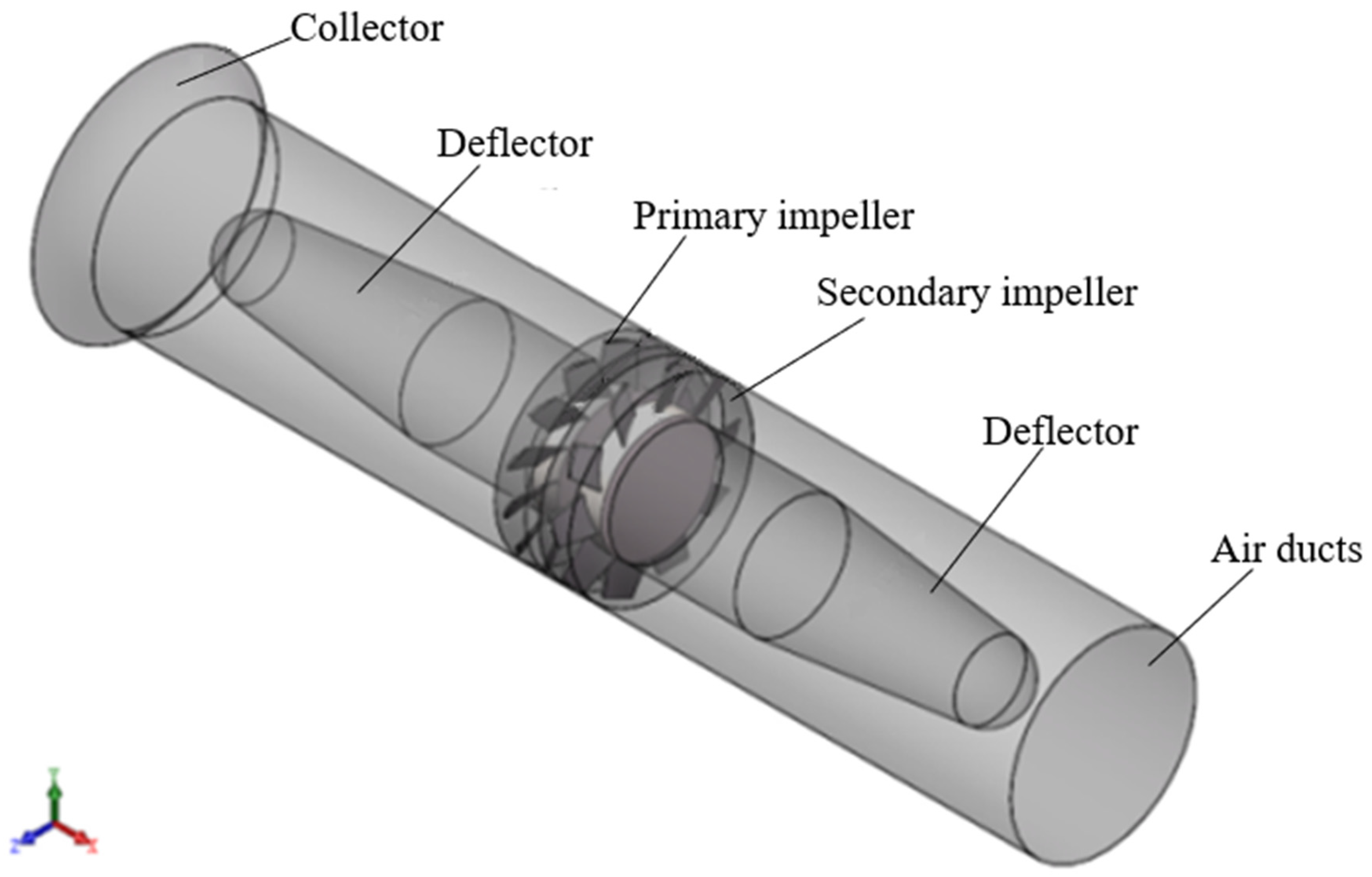

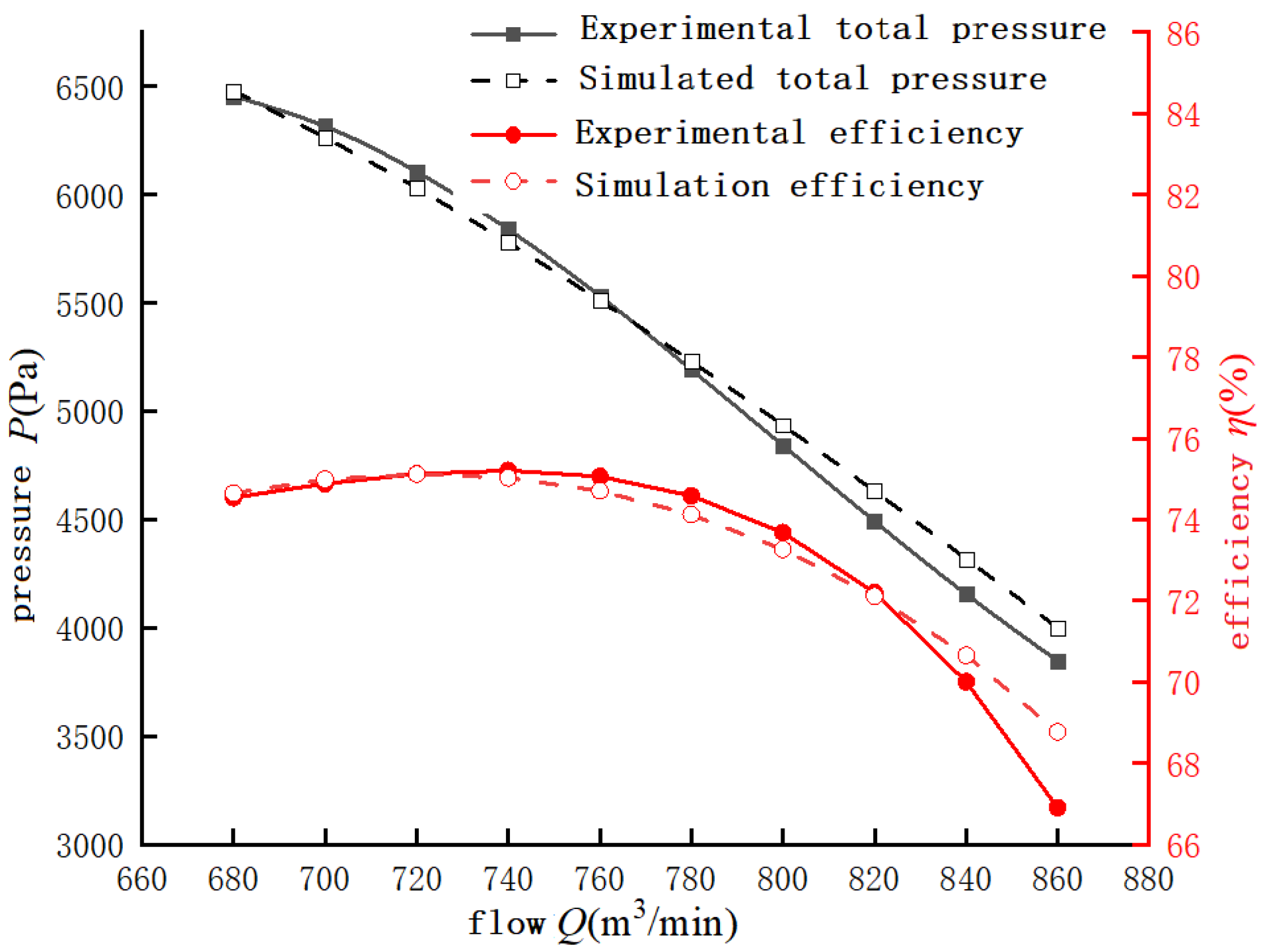

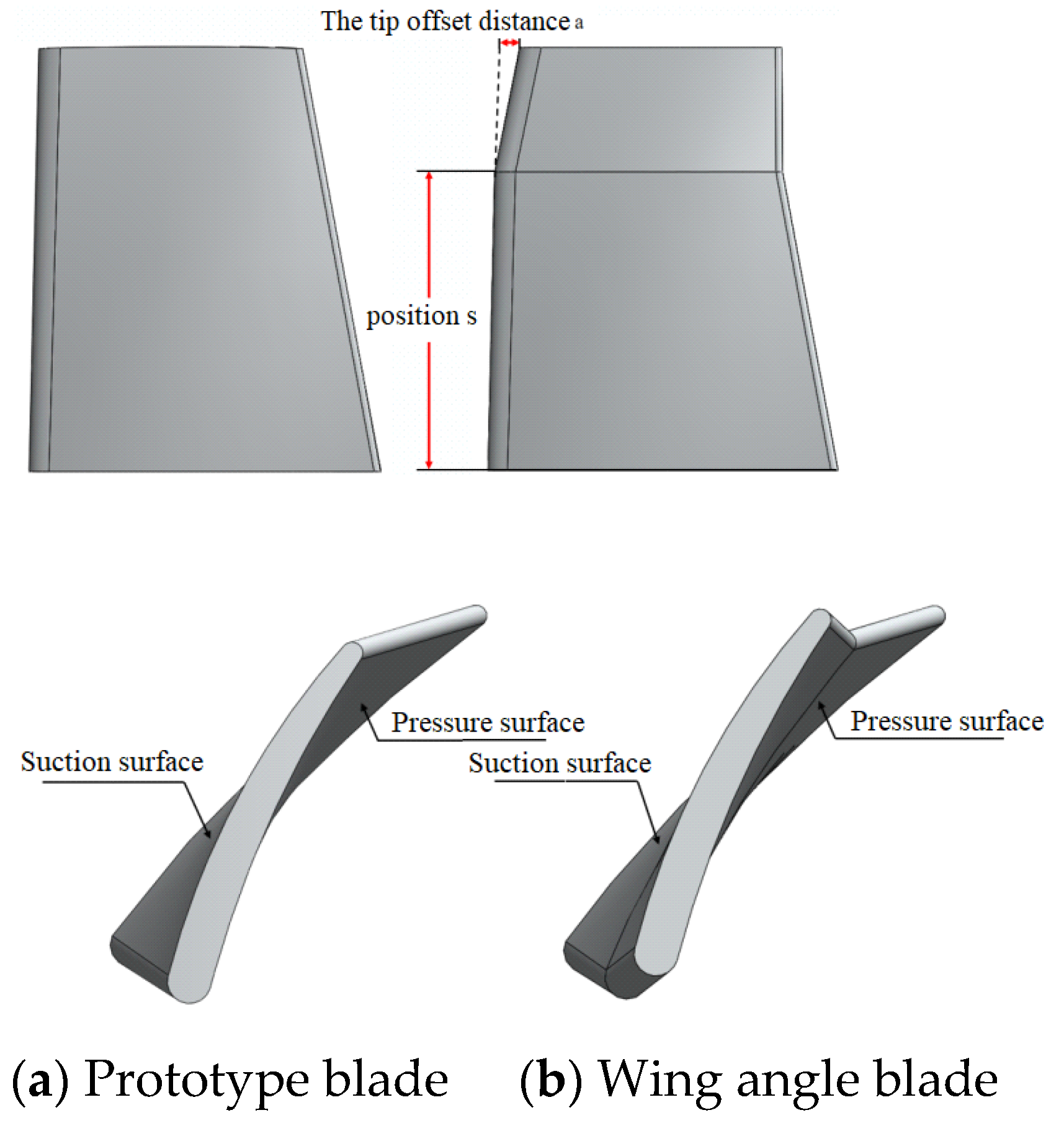
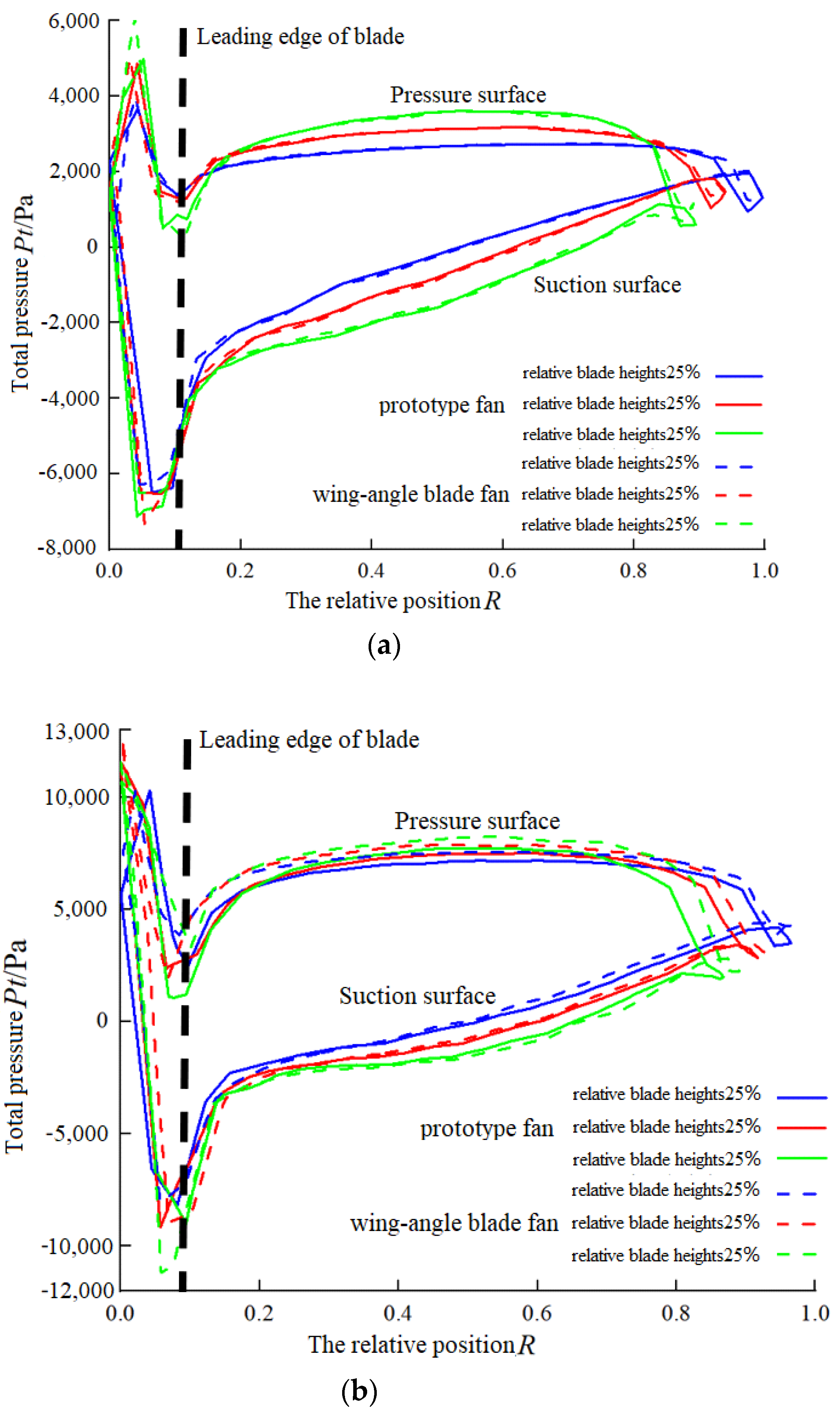
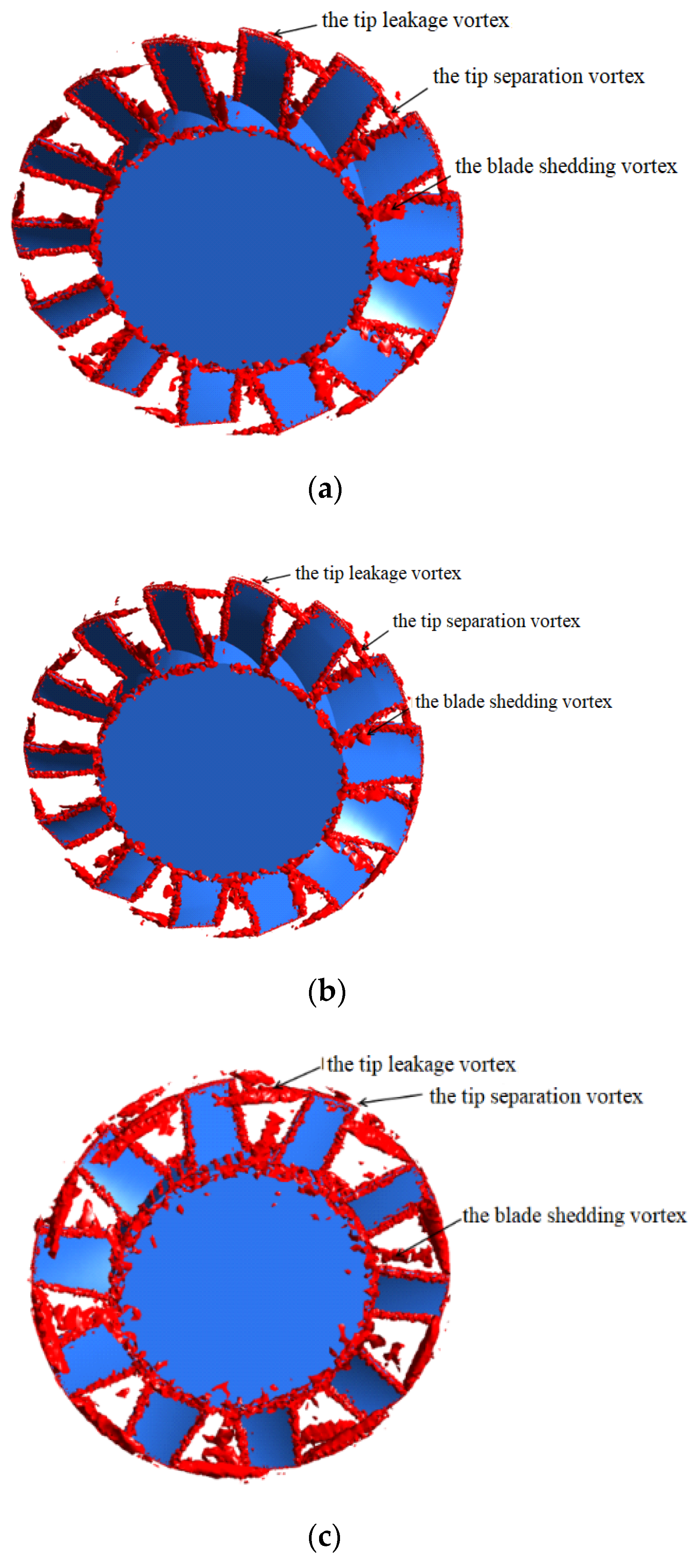
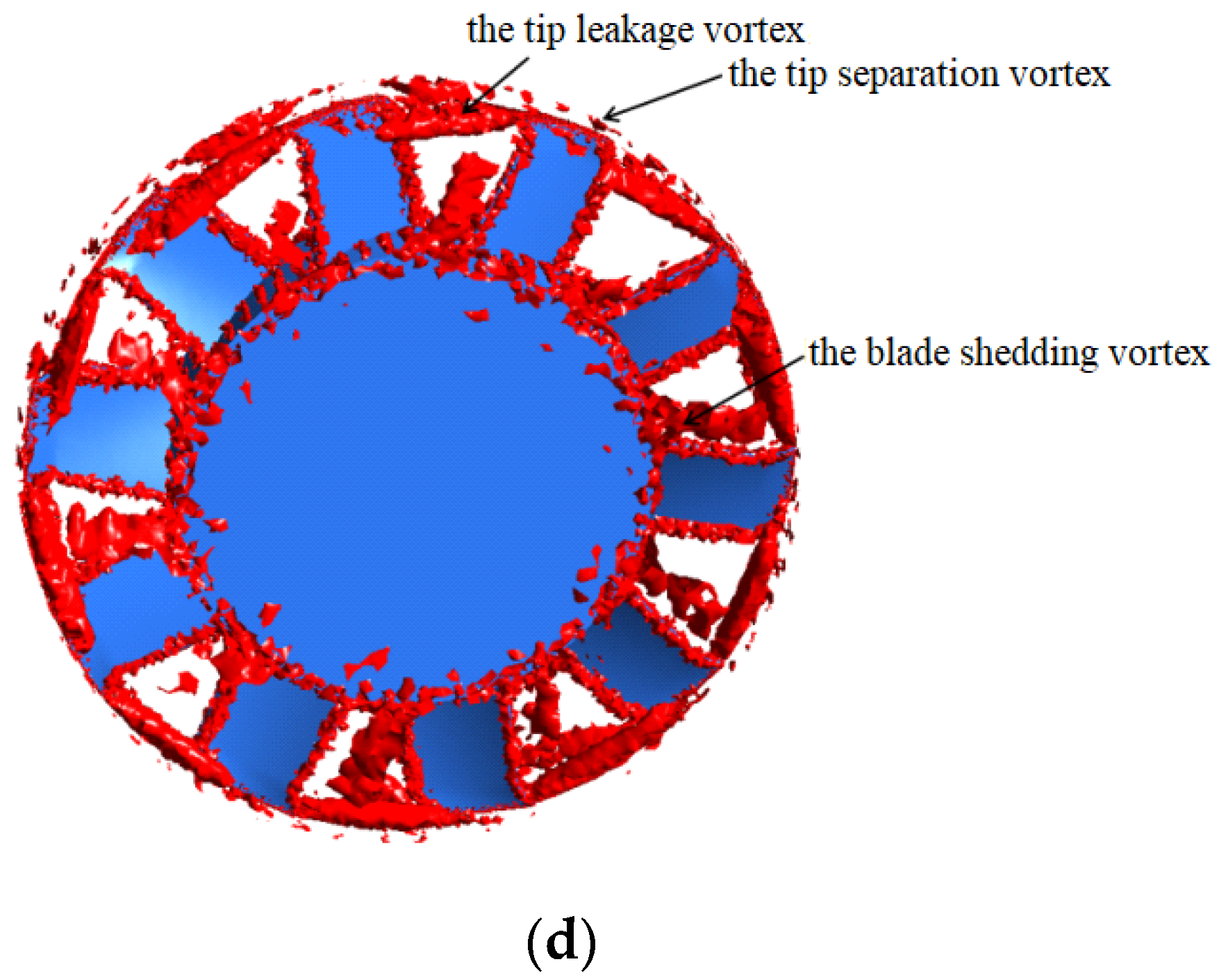

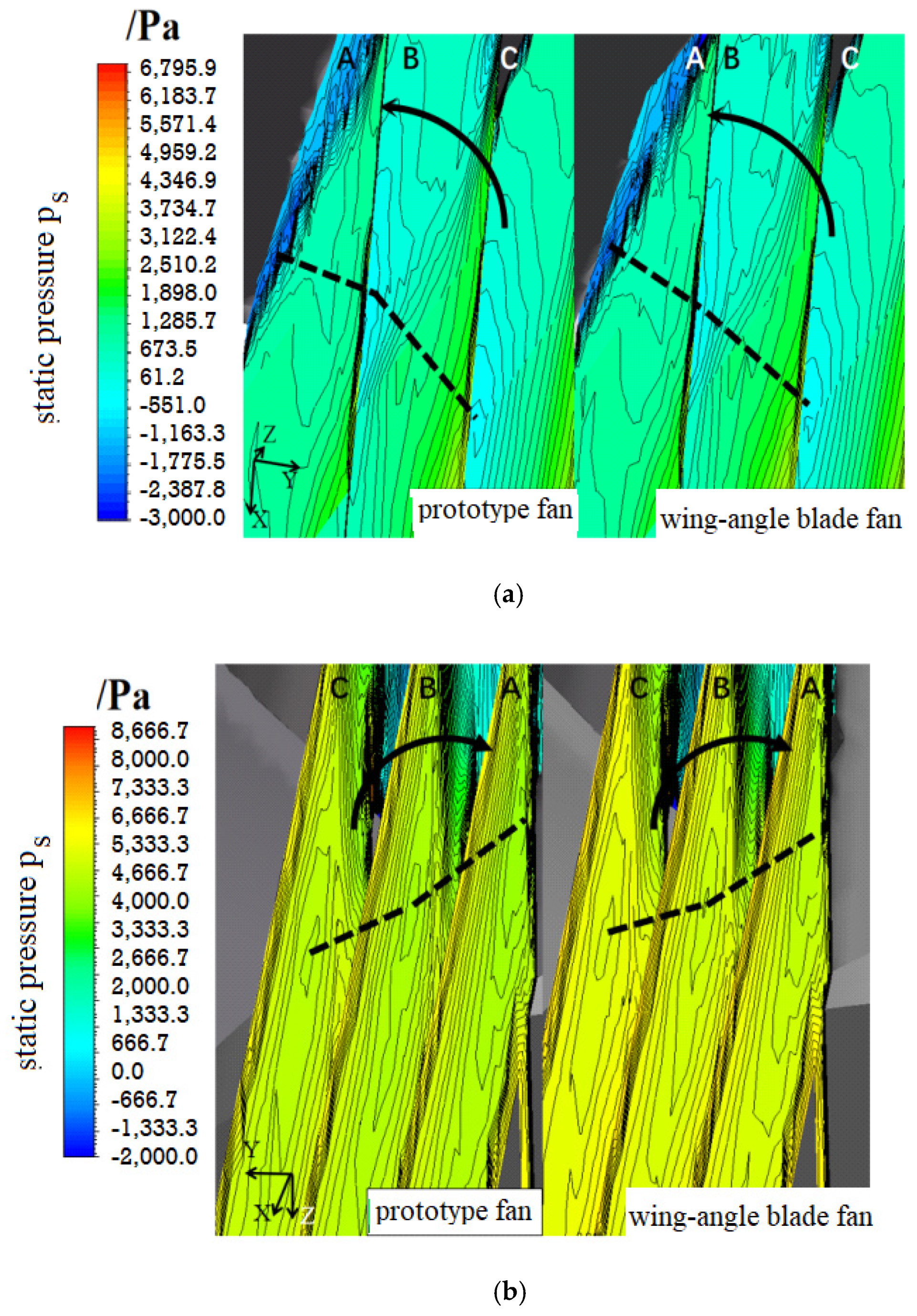
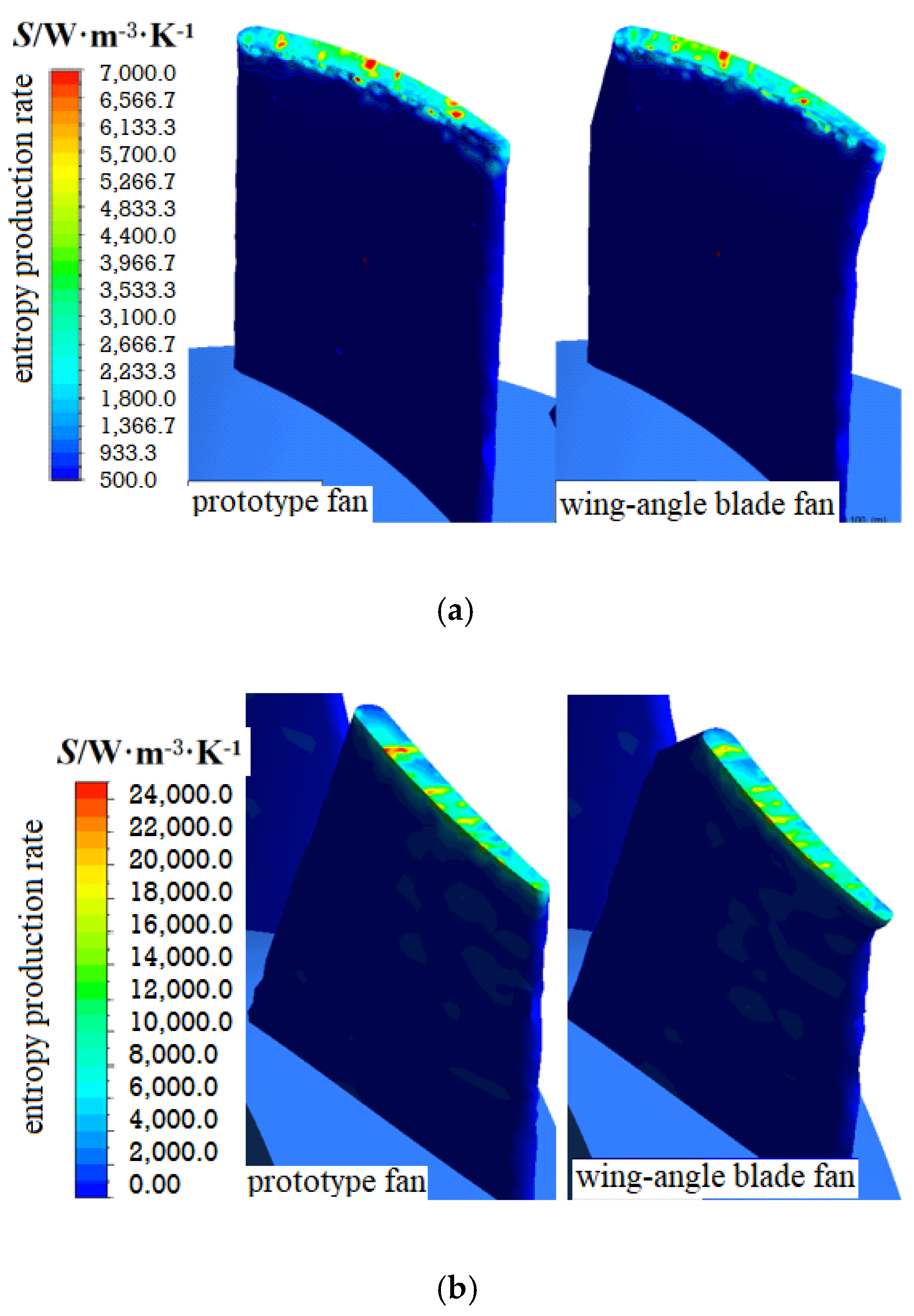
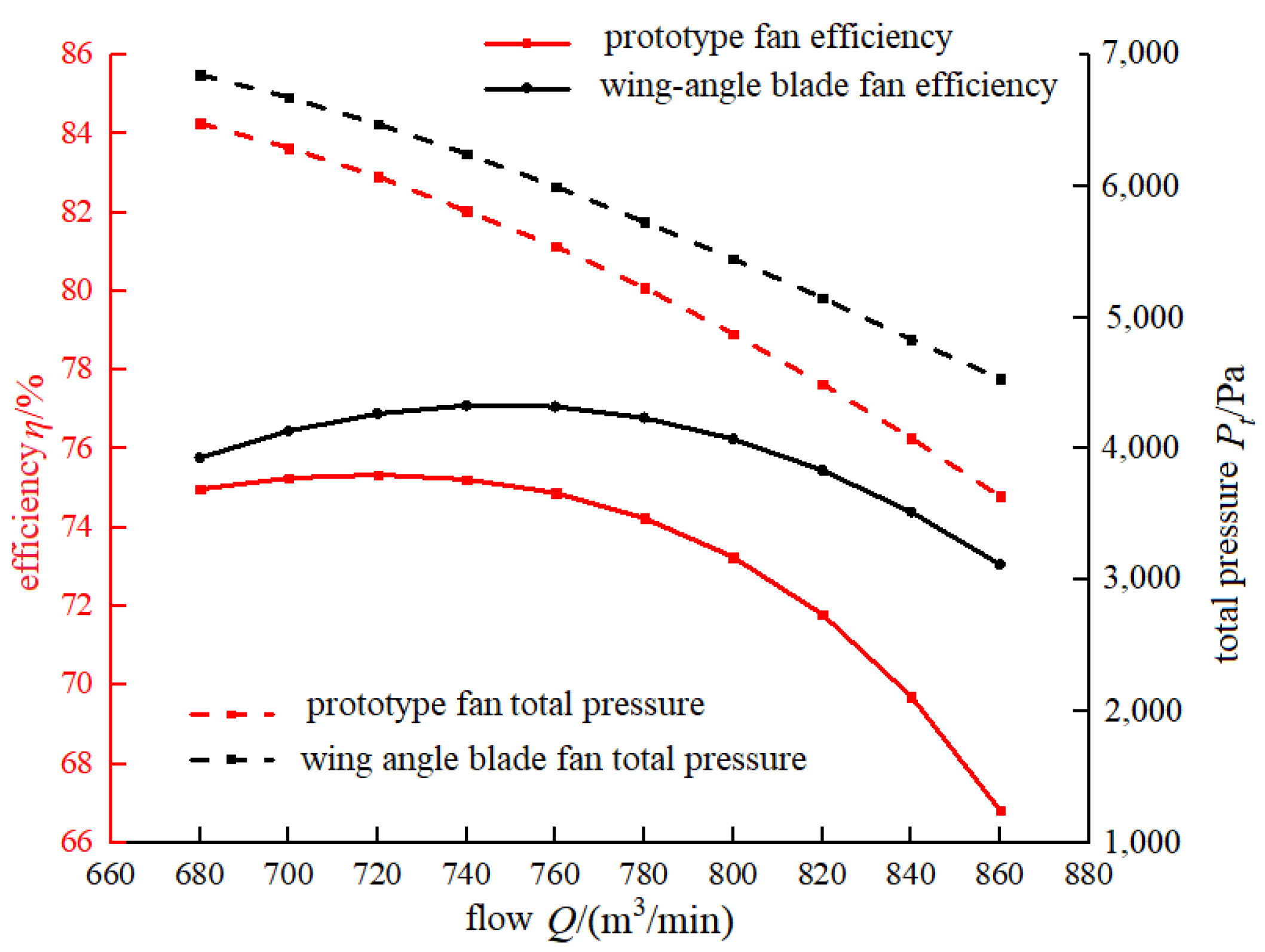

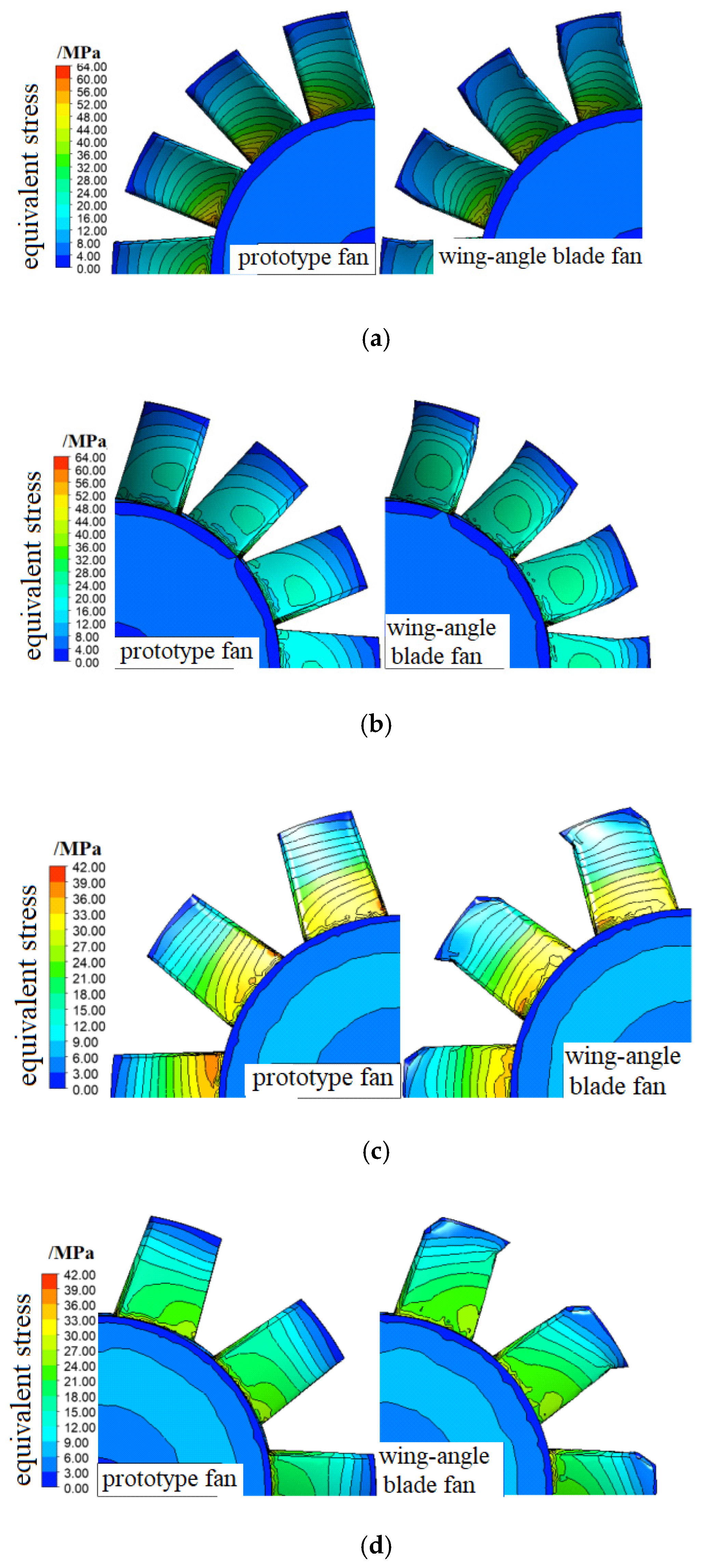
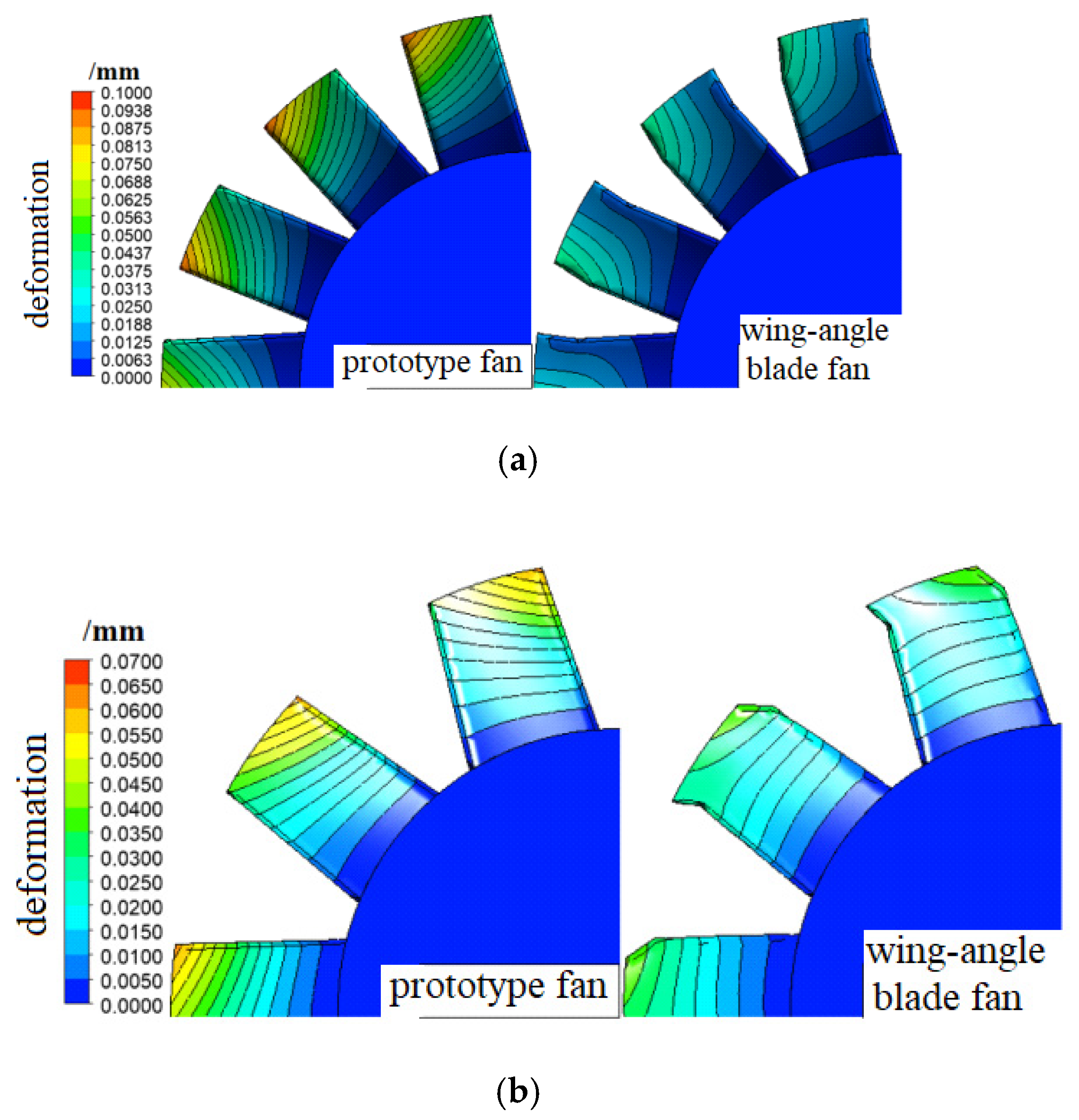
| Design Parameters | Value |
|---|---|
| Number of blades of first-stage impeller | 14 |
| Number of blades of second-stage impeller | 10 |
| One, two leaf height (H/mm) | 150 |
| Chord length of first and second stage blade tip (L/mm) | 111 |
| One, two wheel hub ratio | 0.6 |
| One, two stage tip clearance(mm) | 2 |
| One, two rated speed/(rad/min) | ±2900 |
| Mounting Angle of first-stage blade (°) | 46 |
| Mounting Angle of two-stage blade (°) | 30 |
| The Number of Cells (Million) | The Efficiency (%) | The Number of Cells (Million) | The Efficiency (%) |
|---|---|---|---|
| 1.34 | 72.23 | 1.70 | 71.98 |
| 1.79 | 73.25 | 2.02 | 74.62 |
| 3.22 | 74.50 | 3.64 | 74.56 |
| Test Serial Number | Position of First-Stage Blade Angle A/mm | Tip Offset Distance of First-Stage Blade B/mm | Position of Second-Stage Blade Angle C/mm | Offset Distance of Blade Tip of Second-Stage Impeller D/mm |
|---|---|---|---|---|
| 1 | 100 | 10 | 100 | 10 |
| 2 | 110 | 15 | 110 | 15 |
| 3 | 120 | 20 | 120 | 20 |
| Test Serial Number | Position of First-Stage Blade Angle A/mm | Tip Offset Distance of First-Stage Blade B/mm | Position of Second-Stage Blade Angle C/mm | Tip Offset Distance of Second-Stage Blades B/mm | Efficiency η/% |
|---|---|---|---|---|---|
| 1 | 100 | 10 | 100 | 10 | 76.69 |
| 2 | 100 | 15 | 110 | 15 | 76.36 |
| 3 | 100 | 20 | 120 | 20 | 76.94 |
| 4 | 110 | 10 | 110 | 20 | 76.53 |
| 5 | 110 | 15 | 120 | 10 | 76.45 |
| 6 | 110 | 20 | 100 | 15 | 76.38 |
| 7 | 120 | 10 | 120 | 15 | 76.51 |
| 8 | 120 | 15 | 100 | 20 | 76.32 |
| 9 | 120 | 20 | 110 | 10 | 76.31 |
| k1 | 77.66 | 76.58 | 76.46 | 76.48 | |
| k2 | 76.45 | 76.38 | 76.40 | 76.42 | |
| k3 | 76.38 | 76.54 | 76.63 | 76.60 | |
| Range | 0.28 | 0.20 | 0.23 | 0.18 |
| Type | Entropy Production | Wind Tube | Primary Impeller | Secondary Impeller | Total |
|---|---|---|---|---|---|
| Prototype fan | 0.1186 | 2.2784 | 4.1418 | 6.5388 | |
| 1.1334 | 29.7861 | 41.4495 | 72.3690 | ||
| 1.2520 | 32.0645 | 45.5913 | 78.9078 | ||
| Wing angle blade fan | 0.1150 | 2.2760 | 4.2264 | 6.6174 | |
| 1.0972 | 29.6556 | 40.3174 | 71.0702 | ||
| 1.2122 | 31.9316 | 44.5438 | 77.6876 |
| Blade Stage | Prototype Fan | Wing Angle Blade Fan | ||
|---|---|---|---|---|
| Minimum Equivalent Stress/MPa | Maximum Equivalent Stress/MPa | Minimum Equivalent Stress/MPa | Maximum Equivalent Stress/MPa | |
| First-stage blade | 0.0008 | 61.8577 | 0.0011 | 53.2365 |
| Second-stage blade | 0.0048 | 40.0064 | 0.0046 | 40.4835 |
| Blade Stage | Maximum Deformation/mm | |
|---|---|---|
| Prototype Fan | Wing Angle Blade Fan | |
| First-stage blade | 0.0969 | 0.0463 |
| Second-stage blade | 0.0624 | 0.0411 |
Publisher’s Note: MDPI stays neutral with regard to jurisdictional claims in published maps and institutional affiliations. |
© 2022 by the authors. Licensee MDPI, Basel, Switzerland. This article is an open access article distributed under the terms and conditions of the Creative Commons Attribution (CC BY) license (https://creativecommons.org/licenses/by/4.0/).
Share and Cite
Gao, G.; You, Q.; Kou, Z.; Zhang, X.; Gao, X. Simulation of the Influence of Wing Angle Blades on the Performance of Counter-Rotating Axial Fan. Appl. Sci. 2022, 12, 1968. https://doi.org/10.3390/app12041968
Gao G, You Q, Kou Z, Zhang X, Gao X. Simulation of the Influence of Wing Angle Blades on the Performance of Counter-Rotating Axial Fan. Applied Sciences. 2022; 12(4):1968. https://doi.org/10.3390/app12041968
Chicago/Turabian StyleGao, Guijun, Qingshan You, Ziming Kou, Xin Zhang, and Xinqi Gao. 2022. "Simulation of the Influence of Wing Angle Blades on the Performance of Counter-Rotating Axial Fan" Applied Sciences 12, no. 4: 1968. https://doi.org/10.3390/app12041968
APA StyleGao, G., You, Q., Kou, Z., Zhang, X., & Gao, X. (2022). Simulation of the Influence of Wing Angle Blades on the Performance of Counter-Rotating Axial Fan. Applied Sciences, 12(4), 1968. https://doi.org/10.3390/app12041968






